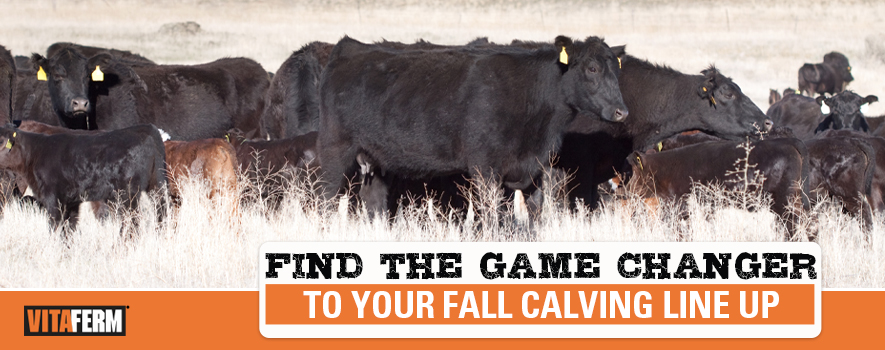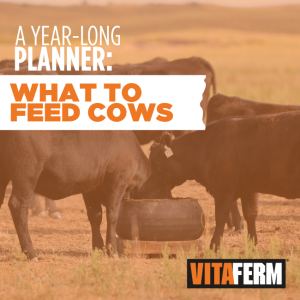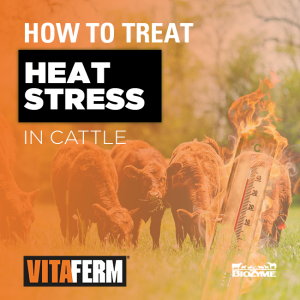
Cattle producers across many parts of the country find benefits to a fall calving program – pasture space is readily available, calving in the open helps keep calves healthier, reducing chances for sickness and the weather lends itself to a more pleasant overall experience with no frozen tails or ears. However, the temperatures can still be a challenge to producers who calve in late summer and early fall when the temperatures heat up.
Heat stress is something we often only consider in the hottest months of the summer. But as Jack Oattes, BioZyme® Inc. Regional Business Manager, explains, heat stress can impact the herd anytime temperatures reach 70 degrees or hotter.
“Heat stress is induced any time the temperature rises above the animal’s thermoneutral zone (TNZ). In cattle that’s approximately 70 degrees. It can cause a multitude of problems that are noticeable – panting or excessive salivation or in some of those extreme cases, cattle can even go down, but the less obvious effect of heat stress is reduction in performance. As producers, we know that performance pays and that is what we want to improve,” he said.
Because the temperatures do stay relatively hot into fall calving, BioZyme offers a game changer for your nutrition program: VitaFerm® Concept•Aid® 5/S HEAT® to help cows get added performance during this already stressful time. VitaFerm Concept•Aid 5/S HEAT is a vitamin and mineral supplement for beef cattle specifically designed for reproductive success when fed 60 days pre-calving through 60 days post-breeding. The HEAT component is a unique blend of clove, cinnamon and chill pepper to help maintain circulation and help those cattle dissipate heat and perform during temperatures of 70 degrees and hotter, or anytime cattle are grazing fescue.
The combination of VitaFerm Concept•Aid and HEAT is definitely a game changer for regions that experience heat during later times of the year or for those spring calving herds that are and trying to maintain pregnancies through the heat of summer.
Justin Maus is a second-generation Angus producer in Southwest North Dakota. He believes in the benefits of both VitaFerm and HEAT, so it was a challenging decision which mineral to feed to make sure his cows received the optimum nutrition they needed.
“I was so excited when they came out with the Concept•Aid 5/S HEAT because for us in the upper Midwest, you wanted to feed Concept•Aid and get your cows bred back up, so you couldn’t feed the HEAT mineral. It was like tugging strings, which one was going to be better for you. So, by being able to have the two in one, it really helped us out up here because we breed our cows in the heat in the summer. It is a very beneficial product,” Maus said. “Concept•Aid 5/S is our staple mineral. I was pretty excited about the 5/S with the HEAT. We spent most of the summer months on the 5/S HEAT, and actually some of our groups are still on the 5/S HEAT. You’re still going to have some flies, but it does reduce them drastically. It helps keep the cows spread out more and grazing more.”
In addition to the HEAT package to help reduce heat stress, VitaFerm Concept•Aid HEAT is highly fortified with levels of vitamin E for reproductive tract repair, 2.5 times the NRC for quicker impact, and formulated with highly bioavailable sources of copper, zinc and manganese as well as Amaferm®. Amaferm is a precision prebiotic that is research-proven to lower body temperature as well as provide more energy from feedstuffs in order to initiate and maintain pregnancy.
“Right now, summer and fall calving cow herds are going through a critical phase of production with calving season and peak lactation, we’re asking a lot of these cows. As we are either approaching or in the middle of breeding season for many herds, producers should keep in mind that their herd may still be experiencing heat stress. VitaFerm Concept•Aid HEAT helps deliver results and maintain performance,” Oattes said.
Producers ask a lot of their cows in short period of time, putting a lot of stress on them – calve, lactate, rebreed. If they can have one stress reduced – heat stress – through a quality nutrition program, they will be more efficient, and the producer will see performance that pays.


